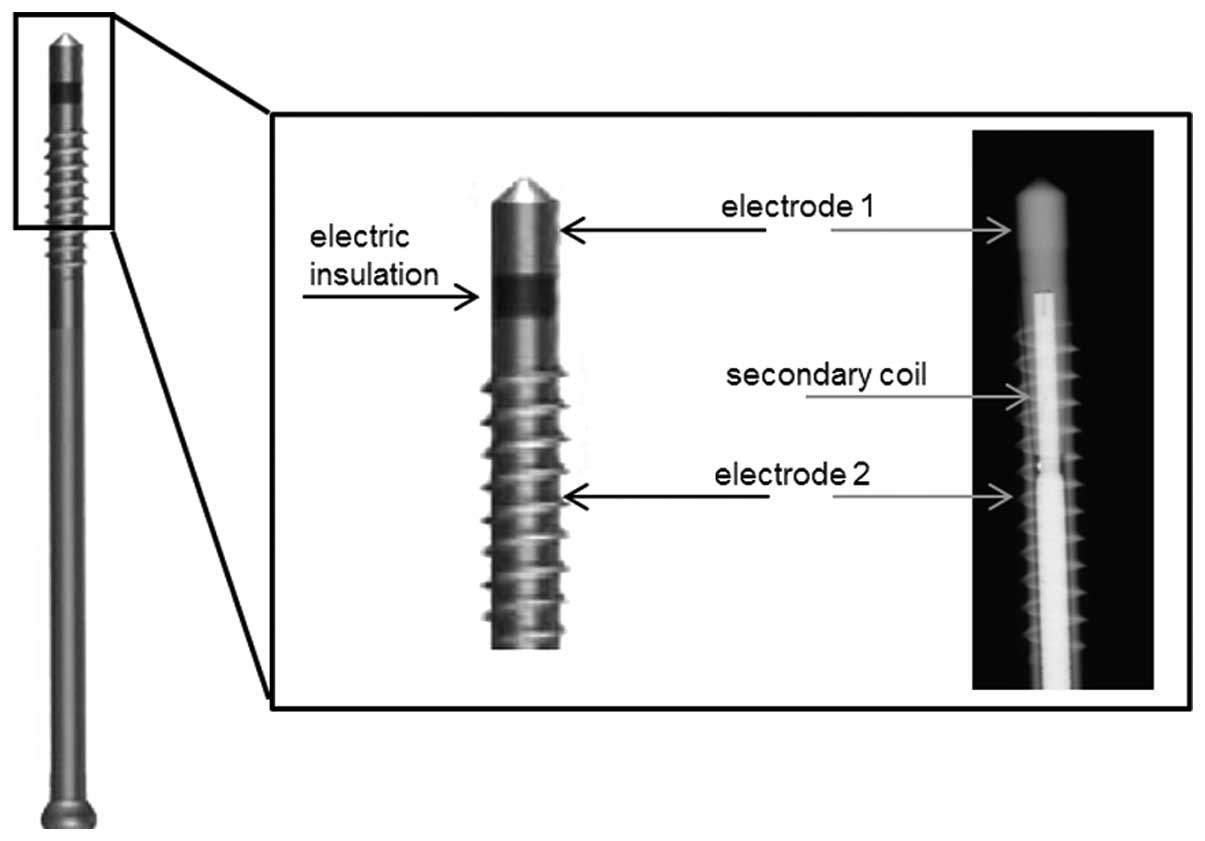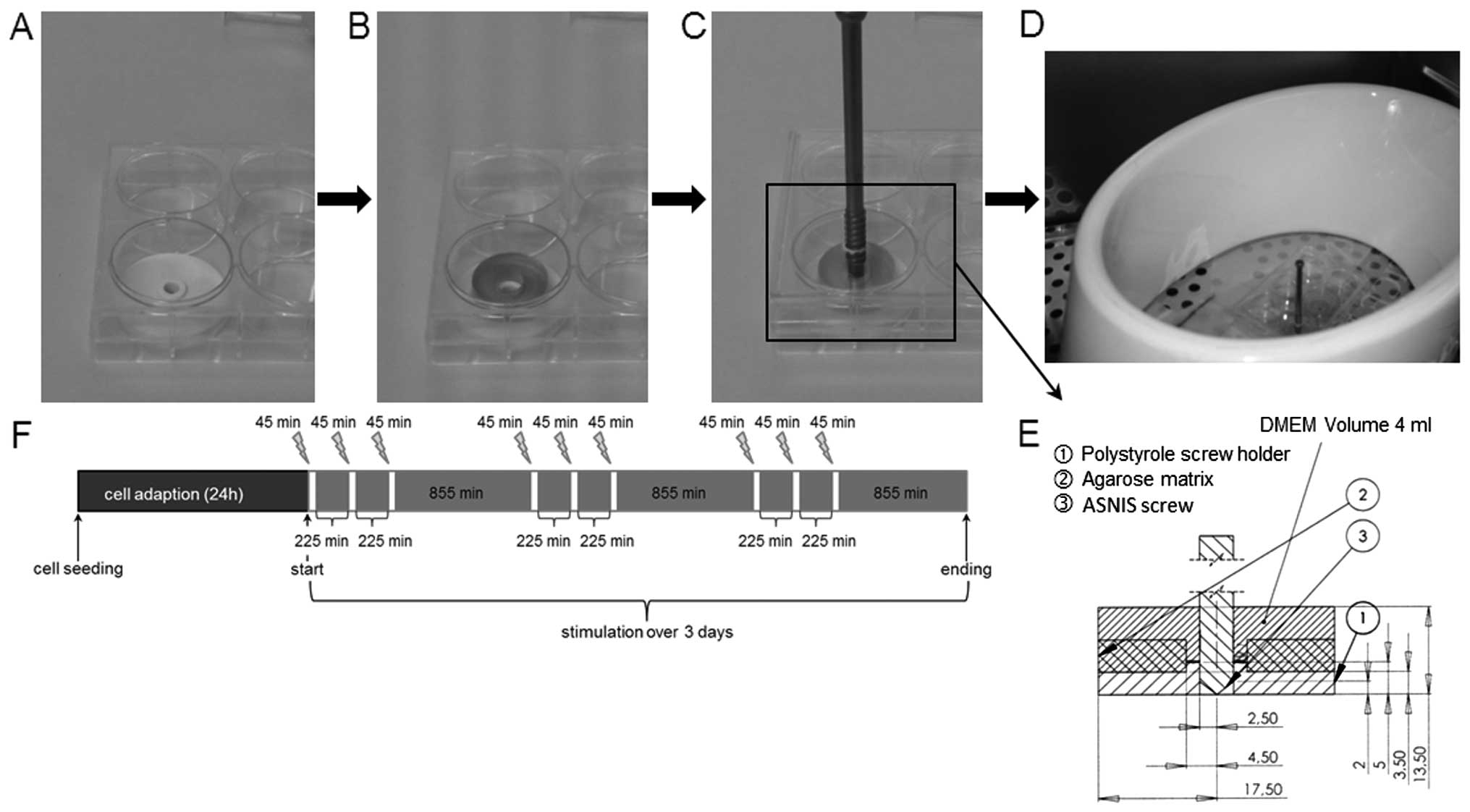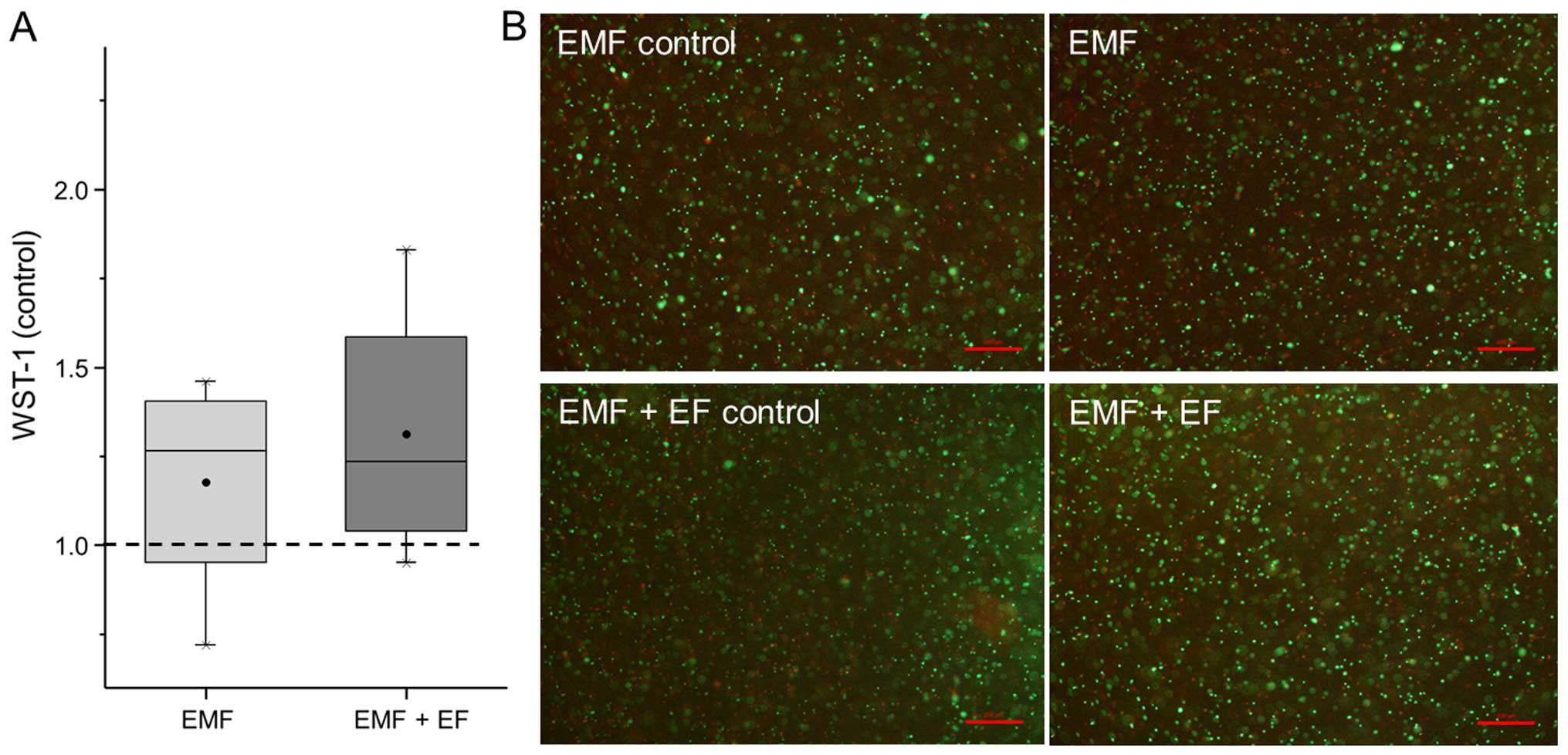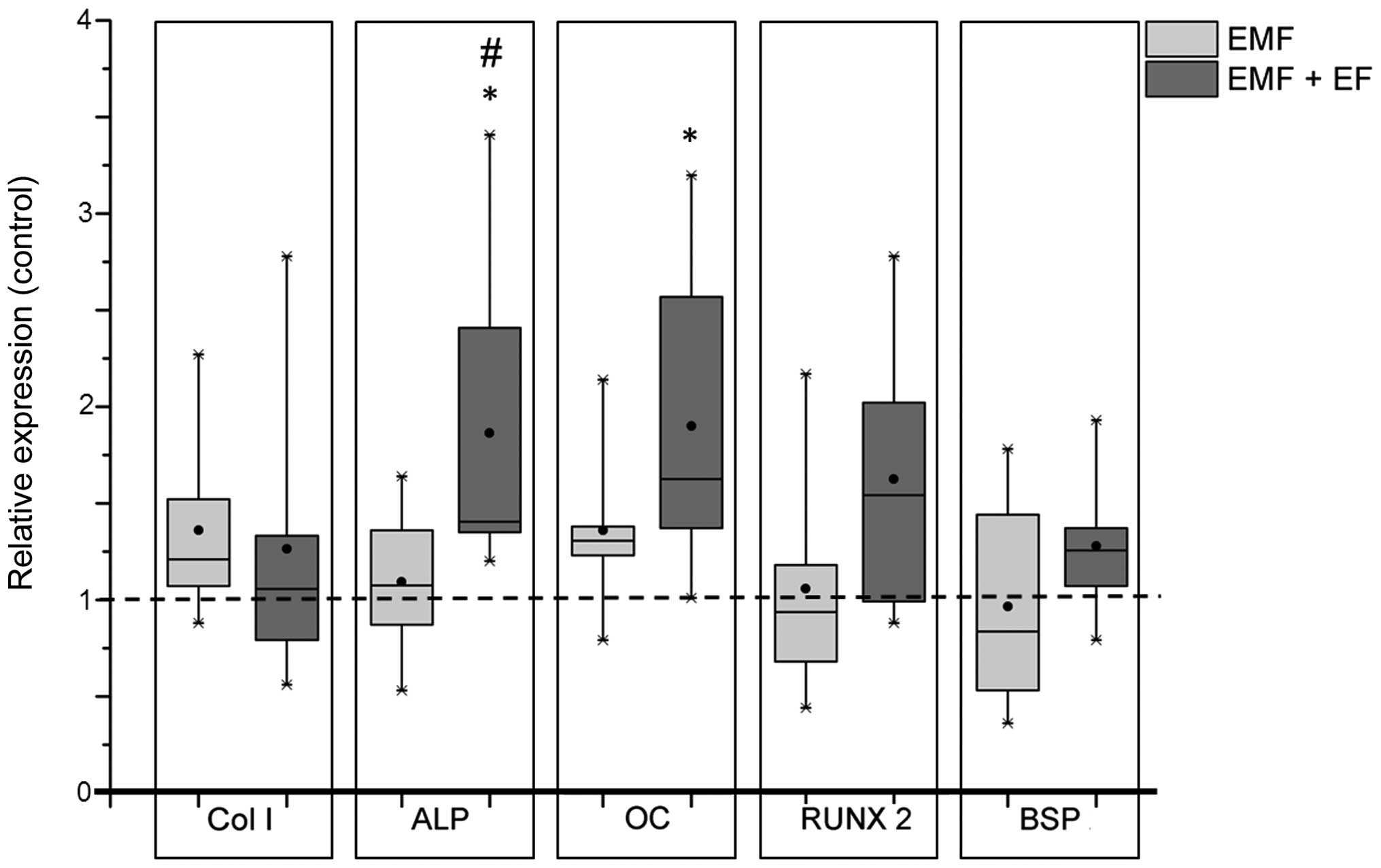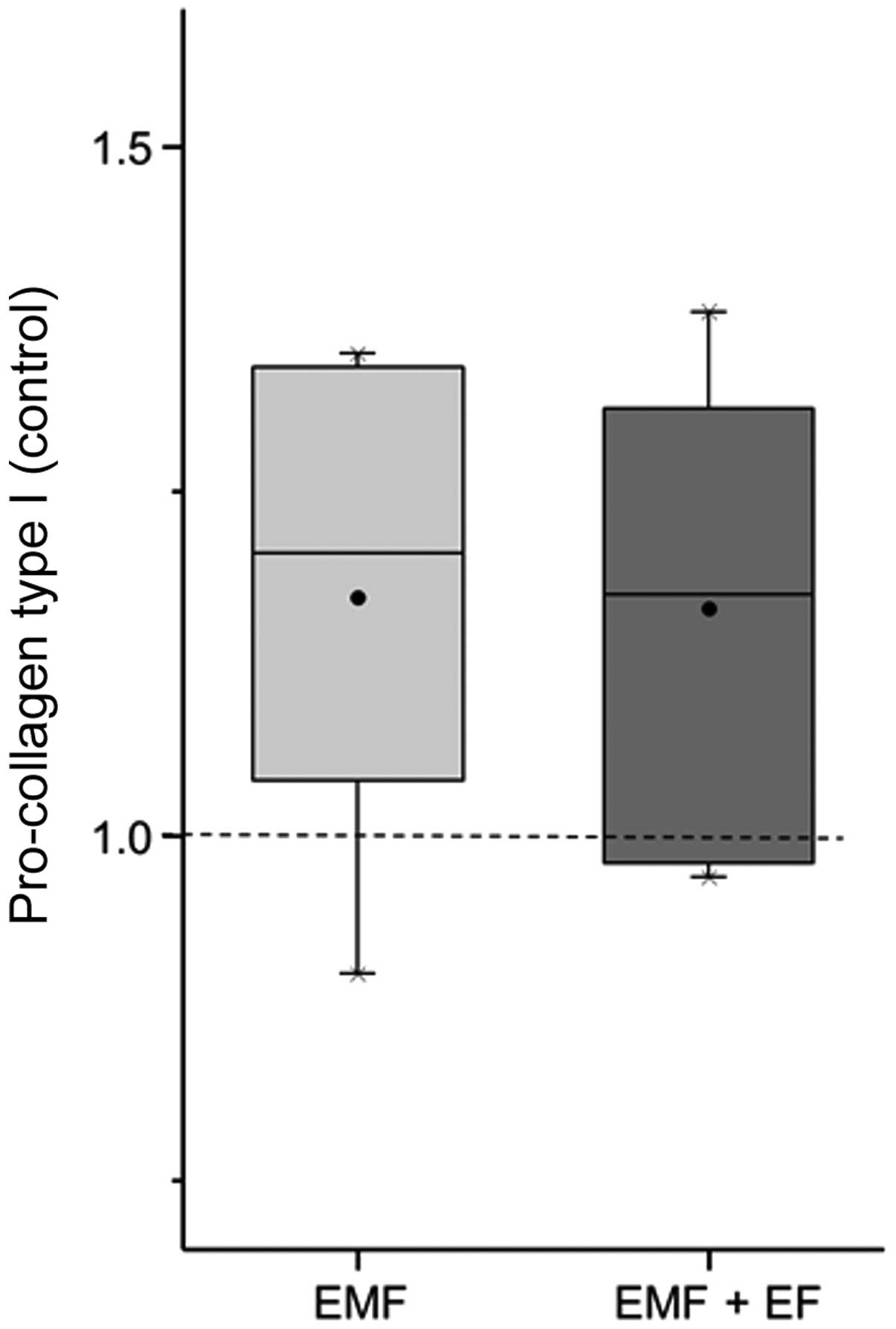|
1
|
Wolf JH: Julis Wolff and his 'law of bone
remodeling'. Orthopade. 24:378–386. 1995.In German. PubMed/NCBI
|
|
2
|
Fukada E and Yasuda I: On the
Piezoelectric Effect of Bone. J Phys Soc Jpn. 12:1158–1162. 1957.
View Article : Google Scholar
|
|
3
|
Icaro Cornaglia A, Casasco M, Riva F,
Farina A, Fassina L, Visai L and Casasco A: Stimulation of
osteoblast growth by an electromagnetic field in a model of
bone-like construct. Eur J Histochem. 50:199–204. 2006.PubMed/NCBI
|
|
4
|
Soda A, Ikehara T, Kinouchi Y and
Yoshizaki K: Effect of exposure to an extremely low
frequency-electromagnetic field on the cellular collagen with
respect to signaling pathways in osteoblast-like cells. J Med
Invest. 55:267–278. 2008. View Article : Google Scholar : PubMed/NCBI
|
|
5
|
Hess R, Neubert H, Seifert A, Bierbaum S,
Hart DA and Scharnweber D: A novel approach for in vitro studies
applying electrical fields to cell cultures by transformer-like
coupling. Cell Biochem Biophys. 64:223–232. 2012. View Article : Google Scholar : PubMed/NCBI
|
|
6
|
Hess R, Jaeschke A, Neubert H, Hintze V,
Moeller S, Schnabelrauch M, Wiesmann HP, Hart DA and Scharnweber D:
Synergistic effect of defined artificial extracellular matrices and
pulsed electric fields on osteogenic differentiation of human MSCs.
Biomaterials. 33:8975–8985. 2012. View Article : Google Scholar : PubMed/NCBI
|
|
7
|
Hronik-Tupaj M, Rice WL, Cronin-Golomb M,
Kaplan DL and Georgakoudi I: Osteoblastic differentiation and
stress response of human mesenchymal stem cells exposed to
alternating current electric fields. Biomed Eng Online. 10:92011.
View Article : Google Scholar : PubMed/NCBI
|
|
8
|
Jansen JH, van der Jagt OP, Punt BJ,
Verhaar JA, van Leeuwen JP, Weinans H and Jahr H: Stimulation of
osteogenic differentiation in human osteoprogenitor cells by pulsed
electromagnetic fields: An in vitro study. BMC Musculoskelet
Disord. 11:1882010. View Article : Google Scholar : PubMed/NCBI
|
|
9
|
Saino E, Fassina L, Van Vlierberghe S,
Avanzini MA, Dubruel P, Magenes G, Visai L and Benazzo F: Effects
of electromagnetic stimulation on osteogenic differentiation of
human mesenchymal stromal cells seeded onto gelatin cryogel. Int J
Immunopathol Pharmacol. 24(Suppl 2): 1–6. 2011.PubMed/NCBI
|
|
10
|
Brighton CT, Wang W, Seldes R, Zhang G and
Pollack SR: Signal transduction in electrically stimulated bone
cells. J Bone Joint Surg Am. 83-A:1514–1523. 2001.PubMed/NCBI
|
|
11
|
Wieland DCF, Krywka C, Mick E,
Willumeit-Römer R, Bader R and Kluess D: Investigation of the
inverse piezoelectric effect of trabecular bone on a micrometer
length scale using synchrotron radiation. Acta Biomater.
25:339–346. 2015. View Article : Google Scholar : PubMed/NCBI
|
|
12
|
Grunert PC, Jonitz-Heincke A, Su Y,
Souffrant R, Hansmann D, Ewald H, Krüger A, Mittelmeier W and Bader
R: Establishment of a novel in vitro test setup for electric and
magnetic stimulation of human osteoblasts. Cell Biochem Biophys.
70:805–817. 2014. View Article : Google Scholar : PubMed/NCBI
|
|
13
|
Balint R, Cassidy NJ and Cartmell SH:
Electrical stimulation: A novel tool for tissue engineering. Tissue
Eng Part B Rev. 19:48–57. 2013. View Article : Google Scholar
|
|
14
|
Kang KS, Hong JM, Jeong YH, Seol YJ, Yong
WJ, Rhie JW and Cho DW: Combined effect of three types of
biophysical stimuli for bone regeneration. Tissue Eng Part A.
20:1767–1777. 2014. View Article : Google Scholar : PubMed/NCBI
|
|
15
|
Puricelli E, Dutra NB and Ponzoni D:
Histological evaluation of the influence of magnetic field
application in autogenous bone grafts in rats. Head Face Med.
5:12009. View Article : Google Scholar : PubMed/NCBI
|
|
16
|
Goldstein C, Sprague S and Petrisor BA:
Electrical stimulation for fracture healing: Current evidence. J
Orthop Trauma. 24(Suppl 1): S62–S65. 2010. View Article : Google Scholar : PubMed/NCBI
|
|
17
|
Kuzyk PR and Schemitsch EH: The science of
electrical stimulation therapy for fracture healing. Indian J
Orthop. 43:127–131. 2009. View Article : Google Scholar : PubMed/NCBI
|
|
18
|
Niethard FU and Pfeil J: Duale Reihe
Orthopädie. 5 Aufl. Thieme; Stuttgart: 2005
|
|
19
|
Mittelmeier W, Lehner S, Kraus W, Matter
HP, Gerdesmeyer L and Steinhauser E: BISS: Concept and
biomechanical investigations of a new screw system for
electromagnetically induced internal osteostimulation. Arch Orthop
Trauma Surg. 124:86–91. 2004. View Article : Google Scholar
|
|
20
|
Fassina L, Visai L, Benazzo F, Benedetti
L, Calligaro A, De Angelis MG, Farina A, Maliardi V and Magenes G:
Effects of electromagnetic stimulation on calcified matrix
production by SAOS-2 cells over a polyurethane porous scaffold.
Tissue Eng. 12:1985–1999. 2006. View Article : Google Scholar : PubMed/NCBI
|
|
21
|
Griffin M, Sebastian A, Colthurst J and
Bayat A: Enhancement of differentiation and mineralisation of
osteoblast-like cells by degenerate electrical waveform in an in
vitro electrical stimulation model compared to capacitive coupling.
PLoS One. 8:e729782013. View Article : Google Scholar : PubMed/NCBI
|
|
22
|
Gillespie PG and Walker RG: Molecular
basis of mechanosensory transduction. Nature. 413:194–202. 2001.
View Article : Google Scholar : PubMed/NCBI
|
|
23
|
Lochner K, Fritsche A, Jonitz A, Hansmann
D, Mueller P, Mueller-Hilke B and Bader R: The potential role of
human osteoblasts for periprosthetic osteolysis following exposure
to wear particles. Int J Mol Med. 28:1055–1063. 2011.PubMed/NCBI
|
|
24
|
Livak KJ and Schmittgen TD: Analysis of
relative gene expression data using real-time quantitative PCR and
the 2(-Delta Delta C(T)) Method. Methods. 25:402–408. 2001.
View Article : Google Scholar
|
|
25
|
Dimitriou R, Jones E, McGonagle D and
Giannoudis PV: Bone regeneration: Current concepts and future
directions. BMC Med. 9:662011. View Article : Google Scholar : PubMed/NCBI
|
|
26
|
Watanabe J, Kashii M, Hirao M, Oka K,
Sugamoto K, Yoshikawa H and Akashi M: Quick-forming
hydroxyapatite/agarose gel composites induce bone regeneration. J
Biomed Mater Res A. 83:845–852. 2007. View Article : Google Scholar : PubMed/NCBI
|
|
27
|
Hanazaki Y, Ito D, Furusawa K, Fukui A and
Sasaki N: Change in the viscoelastic properties of agarose gel by
HAp precipitation by osteoblasts cultured in an agarose gel matrix.
J Biorheol. 1–2:21–28. 2013. View Article : Google Scholar
|
|
28
|
Tabata M, Shimoda T, Sugihara K, Ogomi D,
Ohgushi H and Akashi M: Apatite formed on/in agarose gel as a
bone-grafting material in the treatment of periodontal infrabony
defect. J Biomed Mater Res B Appl Biomater. 75:378–386. 2005.
View Article : Google Scholar : PubMed/NCBI
|
|
29
|
Ji J, Sun W, Wang W, Munyombwe T and Yang
XB: The effect of mechanical loading on osteogenesis of human
dental pulp stromal cells in a novel in vitro model. Cell Tissue
Res. 358:123–133. 2014. View Article : Google Scholar : PubMed/NCBI
|
|
30
|
Bordji K, Jouzeau JY, Mainard D, Payan E,
Netter P, Rie KT, Stucky T and Hage-Ali M: Cytocompatibility of
Ti-6Al-4V and Ti-5Al-2.5Fe alloys according to three surface
treatments, using human fibroblasts and osteoblasts. Biomaterials.
17:929–940. 1996. View Article : Google Scholar : PubMed/NCBI
|
|
31
|
Eisenbarth E, Velten D, Müller M, Thull R
and Breme J: Biocompatibility of β-stabilizing elements of titanium
alloys. Biomaterials. 25:5705–5713. 2004. View Article : Google Scholar : PubMed/NCBI
|
|
32
|
Long M and Rack HJ: Titanium alloys in
total joint replacement - a materials science perspective.
Biomaterials. 19:1621–1639. 1998. View Article : Google Scholar : PubMed/NCBI
|
|
33
|
Fassina L, Visai L, De Angelis MG, Benazzo
F and Magenes G: Surface modification of a porous polyurethane
through a culture of human osteoblasts and an electromagnetic
bioreactor. Technol Health Care. 15:33–45. 2007.PubMed/NCBI
|
|
34
|
Lohmann CH, Schwartz Z, Liu Y, Guerkov H,
Dean DD, Simon B and Boyan BD: Pulsed electromagnetic field
stimulation of MG63 osteoblast-like cells affects differentiation
and local factor production. J Orthop Res. 18:637–646. 2000.
View Article : Google Scholar : PubMed/NCBI
|
|
35
|
Meng S, Rouabhia M and Zhang Z: Electrical
stimulation modulates osteoblast proliferation and bone protein
production through heparin-bioactivated conductive scaffolds.
Bioelectromagnetics. 34:189–199. 2013. View Article : Google Scholar
|
|
36
|
Meng S, Zhang Z and Rouabhia M:
Accelerated osteoblast mineralization on a conductive substrate by
multiple electrical stimulation. J Bone Miner Metab. 29:535–544.
2011. View Article : Google Scholar : PubMed/NCBI
|
|
37
|
Vimalraj S, Arumugam B, Miranda PJ and
Selvamurugan N: Runx2: Structure, function, and phosphorylation in
osteoblast differentiation. Int J Biol Macromol. 78:202–208. 2015.
View Article : Google Scholar : PubMed/NCBI
|
|
38
|
Dubey AK, Gupta SD and Basu B:
Optimization of electrical stimulation parameters for enhanced cell
proliferation on biomaterial surfaces. J Biomed Mater Res B Appl
Biomater. 98:18–29. 2011. View Article : Google Scholar : PubMed/NCBI
|
|
39
|
Salasznyk RM, Klees RF, Hughlock MK and
Plopper GE: ERK signaling pathways regulate the osteogenic
differentiation of human mesenchymal stem cells on collagen I and
vitronectin. Cell Commun Adhes. 11:137–153. 2004. View Article : Google Scholar
|
|
40
|
Salasznyk RM, Williams WA, Boskey A,
Batorsky A and Plopper GE: Adhesion to vitronectin and collagen I
promotes osteogenic differentiation of human mesenchymal stem
cells. J Biomed Biotechnol. 2004:24–34. 2004. View Article : Google Scholar : PubMed/NCBI
|
|
41
|
Bistolfi F: Evidence of interlinks between
bioelectromagnetics and biomechanics: From biophysics to medical
physics. Phys Med. 22:71–95. 2006. View Article : Google Scholar
|
|
42
|
Kim IS, Song JK, Zhang YL, Lee TH, Cho TH,
Song YM, Kim K, Kim SJ and Hwang SJ: Biphasic electric current
stimulates proliferation and induces VEGF production in
osteoblasts. Biochim Biophys Acta. 1763:907–916. 2006. View Article : Google Scholar : PubMed/NCBI
|















